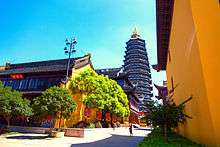East Asian Buddhism

East Asian Buddhism is a collective term for the schools of Mahayana Buddhism that developed in the East Asian region and follow the Chinese Buddhist canon. These include the bodies of Chinese Buddhism, Korean Buddhism, Japanese Buddhism, and Vietnamese Buddhism. They constitute the numerically largest body of Buddhist traditions in the world, over half of the world's Buddhists.[1][2]
Major "schools" of East Asian Buddhism include Pure Land Buddhism, Tiantai, Huayen, and Chan Buddhism (Zen). These are distinguished primarily on the basis of which sutras are considered most definitive (in contrast with the situation in Tibetan Buddhism, where the focus is on commentarial literature). Vajrayana Buddhism also exists in East Asian forms, such as Japan's Shingon sect.
East Asian sangha members generally follow the Dharmaguptaka Vinaya. The major exception is Japan, where monks (now called "priests" in English) received imperial permission to marry during the Meiji Restoration, and thus no longer follow any traditional monastic code.
See also
References
- ↑ Pew Research Center, Global Religious Landscape: Buddhists.
- ↑ Johnson, Todd M.; Grim, Brian J. (2013). The World's Religions in Figures: An Introduction to International Religious Demography (PDF). Hoboken, NJ: Wiley-Blackwell. p. 34. Retrieved 2 September 2013.